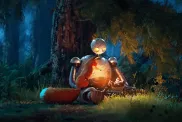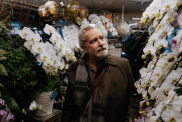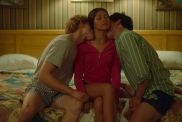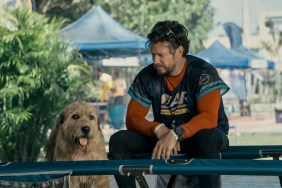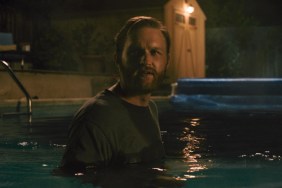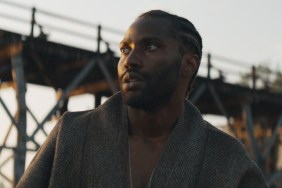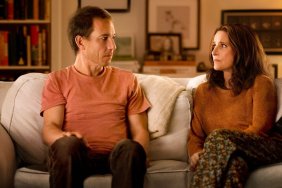
What is in a name? What’s in a word? What does it mean when a director populates a scene with extras, two of which just happen to be dressed up mannequins? Writer/director Peter Strickland‘s The Duke of Burgundy requires you to ask such questions, even if the answer is… “because”.
To begin, the story centers on Cynthia (Sidse Babett Knudsen), a woman who studies butterflies and has developed a sadomasochistic relationship with Evelyn (Chiara D’Anna), at Evelyn’s request. A sort of dramatic tension and almost horror comes as the limits of Cynthia’s love and willingness to do, and go along with, Evelyn’s requests are tested. It’s a story that’s equally romantic as it is unsettling and doesn’t test the audience’s limits with its sexual exploration as much as it isn’t afraid to go down some rather disturbing alleys for those of us that wouldn’t dare go there. I can say more, and I will, however… to read much more may be to spoil the experience for the uninitiated if these opening sentences haven’t done so already.
Let’s begin with the film’s title, a duke is typically known as a male ruler of a small European state, or a male of noble heredity. But this film centers on two women and, in fact, features no men at all. Well, the Duke of Burgundy is actually a European butterfly and the lesbian couple’s safe word used throughout the film, “pinastri”, is a reference to the Sphinx pinastri moth. Is there anything to this or is it simply a use of words and sly metaphors meant to throw us off balance, elevating the slightly unsettling nature of Strickland’s narrative?
I lean more toward the latter, even in the case of the mannequins I mentioned before, which are situated in a conference room as butterfly experts, including Cynthia, offer up their lepidoptera lectures. I’ve read people saying it adds to the sense of the film’s artificiality, or at least the artificial nature of Cynthia and Evelyn’s relationship, but I’m not buying that. I didn’t find anything necessarily artificial about their relationship, unless the belief that Cynthia doing things she may not be comfortable with to satisfy Evelyn’s sexual desires to be artificial… but I don’t. These are clearly acts of love, and as much as they are testing Cynthia’s resolve. The relationship’s so-called artificiality, in this case, has become a romantic reality.
You could take the moth and butterfly metaphors to more simple territory, such as Evelyn’s desire to be locked in a box at night, or cocooned if you will. Or Cynthia’s eventual shedding of the uncomfortable bustiers and lingerie Evelyn buys for as another metaphor, but in the grand scheme of things I think it’s merely an element of Strickland’s controlled “madness” in a movie that is so exquisitely designed, acted and directed you can’t take your eyes off it.
Cynthia’s house can best be described as a stone mansion, draped in lush foliage. The golden trees below blow in the wind, sheltering a babbling stream beneath their canopy. Inside, sunlight beams through the windows to capture a setting almost frozen in time. Candles light the way as Strickland uses mirrors and glass to equally hide and show us the deeds that take place within. Equally stunning locations, such as a winding, amber staircase leading to the library and a white bench set on a hillside outside Cynthia’s stately home, set the mood as much as they please the eye.
The camera seems to gently caress the soapy, bursting bubbles in the wash bin as Evelyn cleans Cynthia’s unmentionables before hanging them to dry, gently dripping on the line as she seeks her lover’s “approval”, knowing full well she won’t be getting it. If ever there was a film that could exhibit the gleam in one character’s eye at the mention of a “human toilet” and not cause the audience to either gag or laugh in response has clearly achieved its goal and that is The Duke of Burgundy.
Knudsen and D’Anna are wonderful, both strong and weak in their portrayals of Cynthia and Evelyn respectively. And the way Strickland reveals their motives, wants and desires allows the audience to play along, always believing there is something more to these characters than what we’re initially given.
The Duke of Burgundy could have gone in so many directions after its midway point and Strickland isn’t shy of reminding us the control he has over the narrative and his characters. In many ways he holds a kinship with Evelyn in that she is as much Cynthia’s director as he is to his characters, though he is the ultimate dominant in this relationship. He holds the power over what happens with these two and a dream sequence late in the picture reminds of this fact, playing out a grisly scenario everyone will consider at least once over the course of the film’s running time.
I have yet to Strickland’s highly acclaimed Berberian Sound Studio, but after witnessing his directorial control over this feature, which could have gone wildly wrong, his other films become immediate must sees as does whatever else he has up his sleeve in the future.
